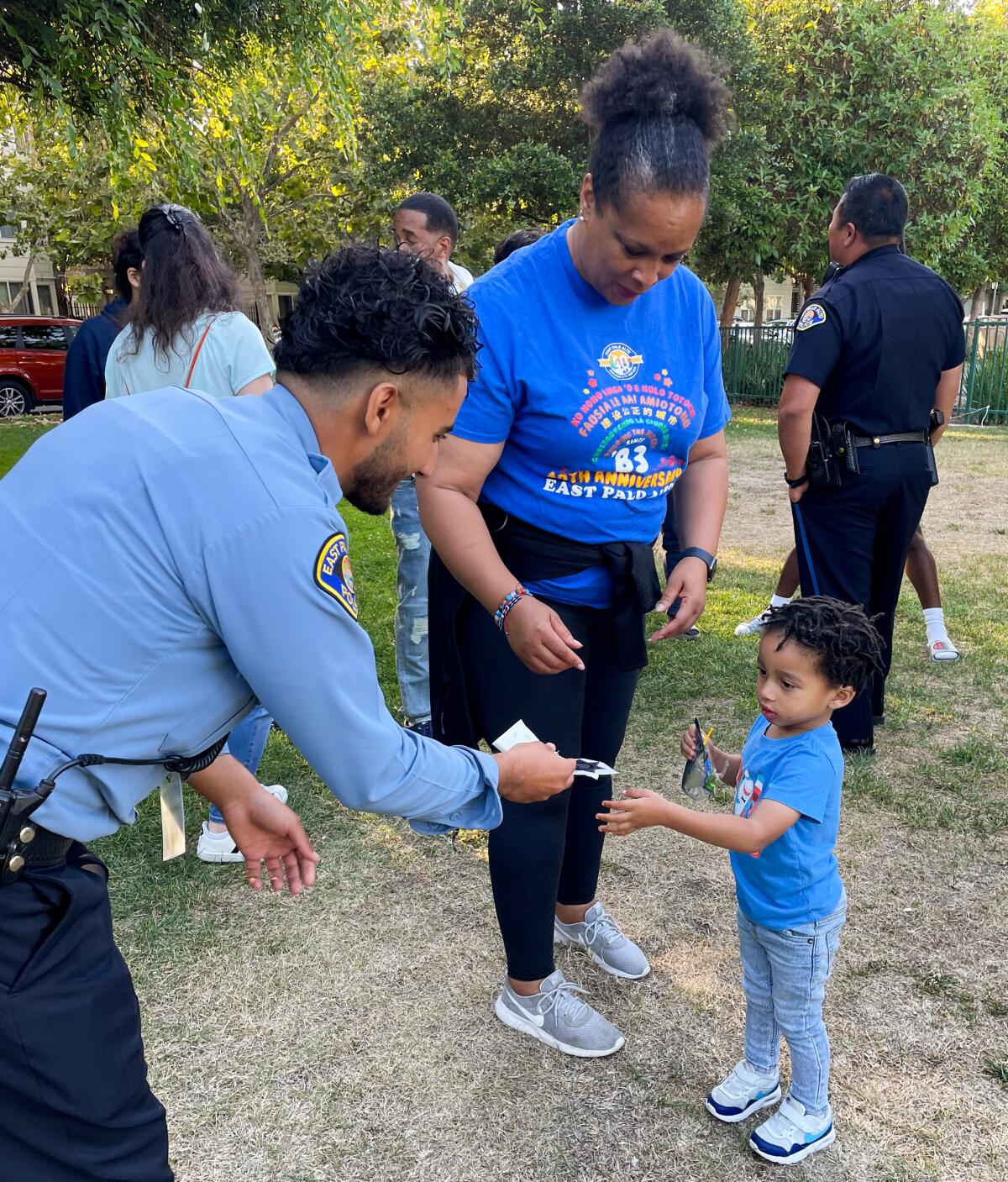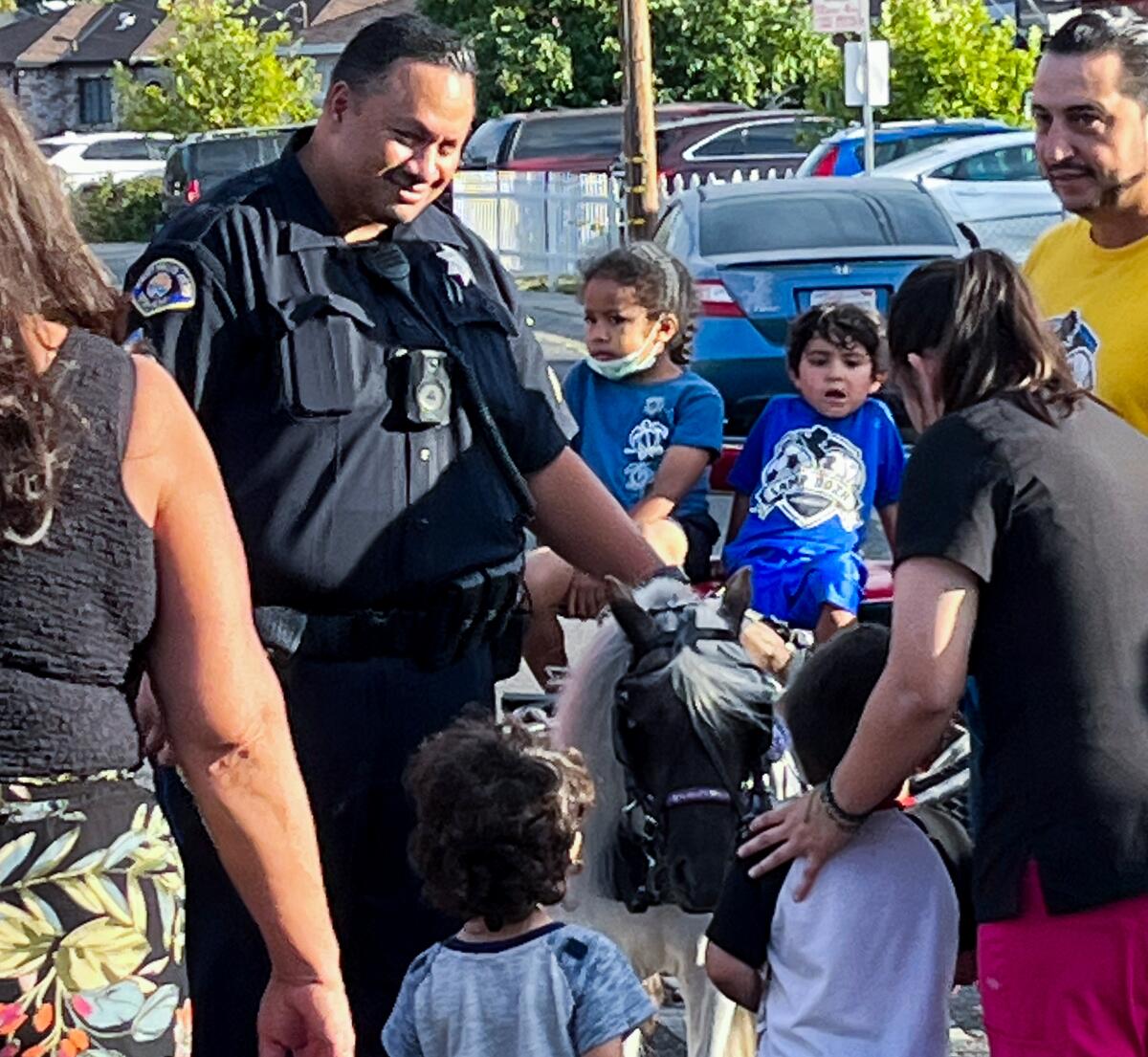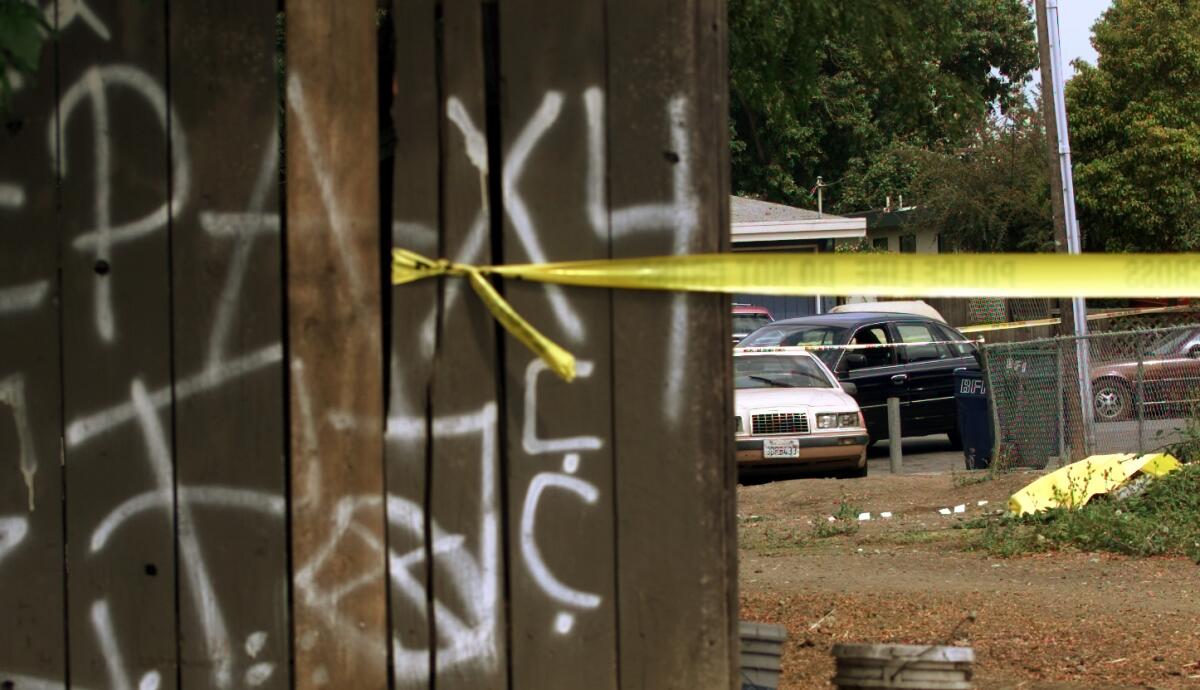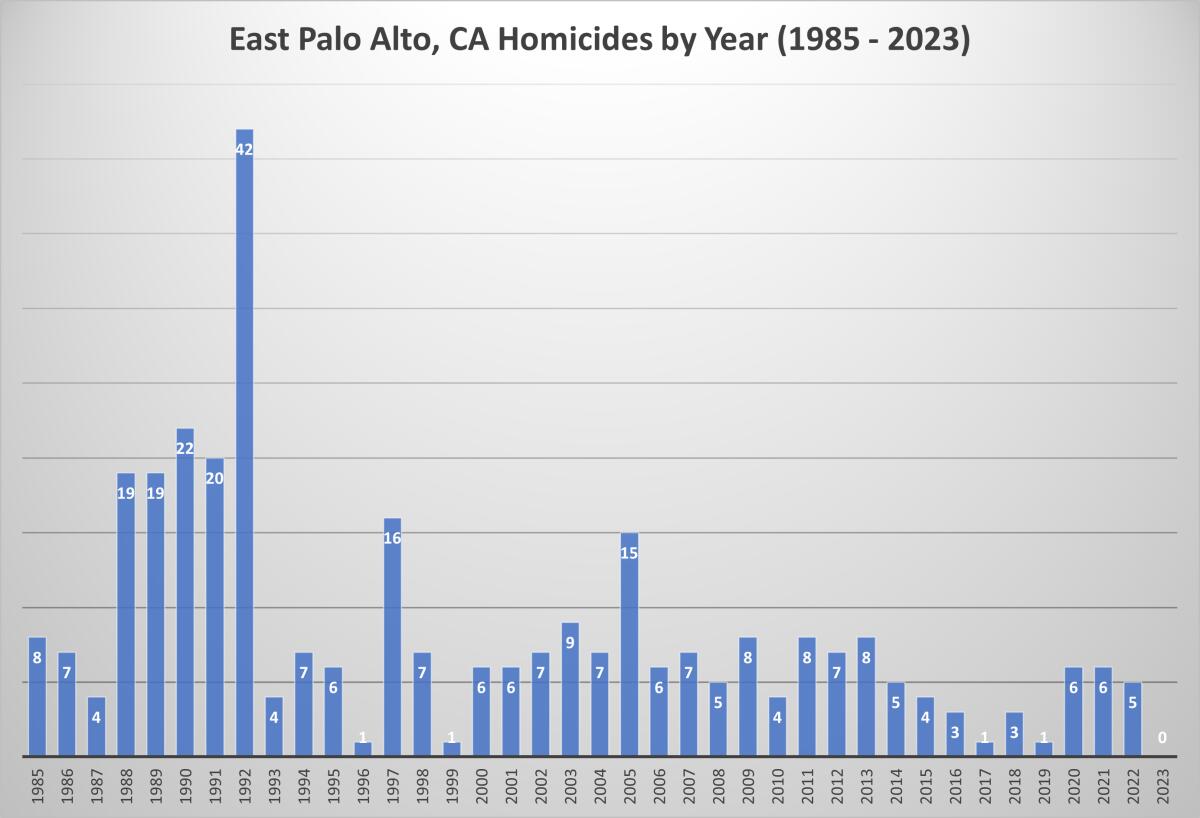A California city’s transformation from ‘murder capital’ of the U.S. to zero homicides

This is what it took to make a small city safe.
In 1992, East Palo Alto was dubbed the “murder capital” of the U.S., with 42 murders in its 2.5 square miles — a per capita rate higher than that of any other city of any size. In 2023, according to East Palo Alto Police Department statistics released last week, the turnaround seemed complete: zero homicides.
Law enforcement leaders, residents and city officials point to a complicated mix of circumstances that turned a crime-ridden community into what the mayor now calls “one of the safest places to live in the peninsula.”
The San Francisco Peninsula that Mayor Antonio López referred to is home to Stanford University, the opulent town of Atherton and well-heeled Palo Alto. Residents and city leaders scoff at the overly simple idea that gentrification solved the city’s problems, although the median household income has drastically increased, and the typical home price is a little more than $900,000.
They argue that poverty and crime don’t necessarily go hand in hand. They point to increased development since they earned the grim title of murder capital, including an Ikea and a Four Seasons hotel. Also: more job opportunities, programs for youth and community policing. And time.
“In spite of the wrongs of our past, we can move forward and be a model for everyone,” López said.
::

East Palo Alto, wedged between San Francisco Bay and Palo Alto, was home to a little more than 28,000 people in the last census count. The median household income is $103,000.
As tech companies in surrounding areas flourished, the city experienced significant gentrification. Rising housing prices left some low-income East Palo Altans feeling pushed out.
Now majority Latino, East Palo Alto was once a landing spot for Black families facing redlining by lenders and real estate agents.
It’s where Paul Bains’ family landed in 1962, at a time when the city was majority Black.
“East Palo Alto was considered like a small Black mecca,” said Bains, who lives and works there to this day.
Many people of color owned homes and looked out for one another, he said. Bains, the pastor for St. Samuel Church, refers to that time as “BC” — before crack.
During the nation’s crack cocaine epidemic, about 17% of East Palo Alto residents lived in poverty, higher than the national level.
“When crack came along, it just demoralized families,” Bains said.
East Palo Alto was also enduring growing pains. After years of neglect by the San Mateo County government, the community voted to incorporate as a city in 1983.
Paul Norris started with the newly formed East Palo Alto Police Department soon after, in 1987, when there were “drug sales on almost every street.” Although there were only four homicides that year, the number increased dramatically in the years that followed, hitting double digits.

The majority of homicides, Norris said, were tied to drug dealers and gang members fighting over territory.
Norris, now an acting sergeant with the department, recalled working a night shift when there were six shootings around the city. He waited with a body for 45 minutes before paramedics could arrive.
“It just seemed like a war zone,” he said.
Clyde Virges was on the front lines. Raised in East Palo Alto, he had gone away to college and returned in the late 1980s with a drug problem. Drugs were so plentiful, he said, he could find them littering the street, the fallen crumbs of sales to users who had driven to the troubled city to buy.
“You’d take a match cover and scrape up what you could get off the ground,” he said.
Gunfire was the city’s soundtrack. Residents used to say that in Palo Alto, there were drive-ins; in East Palo Alto, there were drive-bys.
Picked-over, poverty-pocketed, crime-troubled East Palo Alto--a run-down anomaly in one of the nation’s wealthiest counties--may not impress the casual visitor.
One New Year’s Eve, Virges pulled a flower pot over his head to protect himself as he went to buy crack cocaine, he recalled.
Virges found himself caught up in the crackdown in the ’90s, getting arrested after selling controlled substances to an undercover informant who caught him on video. He called it a blessing.
He spent nearly a year in a recovery home before going to school to become a licensed drug and alcohol counselor. Now 70, he works as a case manager with the nonprofit organization WeHope in East Palo Alto, helping the homeless.
::
In 1992, East Palo Alto gained nationwide notoriety.
At the time, the city was home to 24,000 people, and it recorded the highest murder rate in the U.S. Homicides jumped to 42 from 20 the year before.

It was the equivalent of 175 slayings for every 100,000 residents.
“It brought us a hell of a lot of attention here in the state of California,” said Burnham Matthews, the police chief at the time. “It was a city that really needed some help.”
Help came in the form of outside law enforcement. Palo Alto donated four officers; Menlo Park provided two. Later, the San Mateo County Sheriff’s Department brought in 18 deputies, and the state assigned 12 Highway Patrol officers. The outside officers more than doubled the strength of the department.
Cursed by a flourishing drug trade and violent gang wars, the small Bay Area city of East Palo Alto recorded the highest murder rate in the nation during 1992.
By 1993, according to police statistics, the number of homicides dropped to four.
Sharifa Wilson, who was mayor in 1992, said she welcomed the police support at the time but stressed that it was “not the answer.”
“Part of the issue ... was a lack of economic opportunity,” the 73-year-old said. “We didn’t have access to capital to help establish ourselves.”
Thanks to the attention on East Palo Alto, she said, the city was able to get help from the state and move forward with the development of a shopping center — with a policy in place requiring all businesses to hire from the community.
“We don’t raise our kids to be drug dealers,” she said. “By creating opportunities for them to work, that had an impact.”
Wilson, who still lives in the city, also credited the community for the reduction in crime. At one point, residents formed a group called “Just Us” and would go to street corners and take pictures of the license plates of those driving in to buy drugs. From there, police sent letters to the registered owners notifying them that their cars had been seen in a high-drug, high-crime area. (Wilson said one of the letters went to a judge whose son was using the car to buy drugs.)
Local nonprofit and faith-based groups focused on engaging youth in after-school programs and activities that would steer them away from crime.
“It really is a testament to the commitment of the community to fix itself,” Wilson said. “East Palo Alto has always been a resilient community. People there are really concerned and care about the community where they live.
“The fact that we were labeled the homicide capital gave us an attention that we needed, and then we took that attention and turned it into something positive,” she added. “If you give us lemons, we’re gonna make lemonade.”
::

For 17 years, the number of homicides in East Palo Alto remained in the single digits. In 2017 and again in 2019, there was one murder in the city.
Shortly after midnight this New Year’s Day, Police Chief Jeff Liu texted city officials with the news they had long hoped to hear. Finally, the number of homicides in East Palo Alto had fallen to zero.
“We’ve always had at least one, and to reach zero is just such a monumental achievement for our whole community,” Liu said. “It’s like the goal that always slipped through our fingers.”
Along with the work of his police force, Liu credited residents and the efforts they put into reducing crime, through helping youth and alerting officers to what was happening in the city. That wouldn’t be possible, he said, if the department hadn’t built up trust.
When López heard the news, he said, “it almost made me cry.” The mayor cited the investment the city made in funding for the police force so its salaries would be on par with those of other law enforcement agencies.
“What I love about East Palo Alto is not only is it a model for our peninsula but also the country about how community policing can be effective,” he said.
With homicides down to zero, leaders are optimistic about the future.
Bains, the pastor and co-founder and president of WeHope, said he’s “proud of our city.”
“There’s so many heroes that we stand on the shoulders of that stayed in this community and saw the best of times before, to the worst of times, now back to the better of times,” he said. “Now that we have zero murders, we want to keep it at zero murders.”
More to Read
Sign up for Essential California
The most important California stories and recommendations in your inbox every morning.
You may occasionally receive promotional content from the Los Angeles Times.











